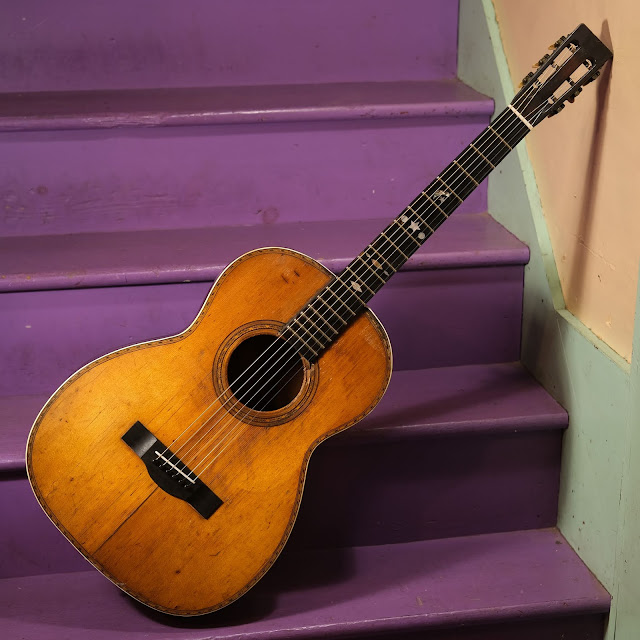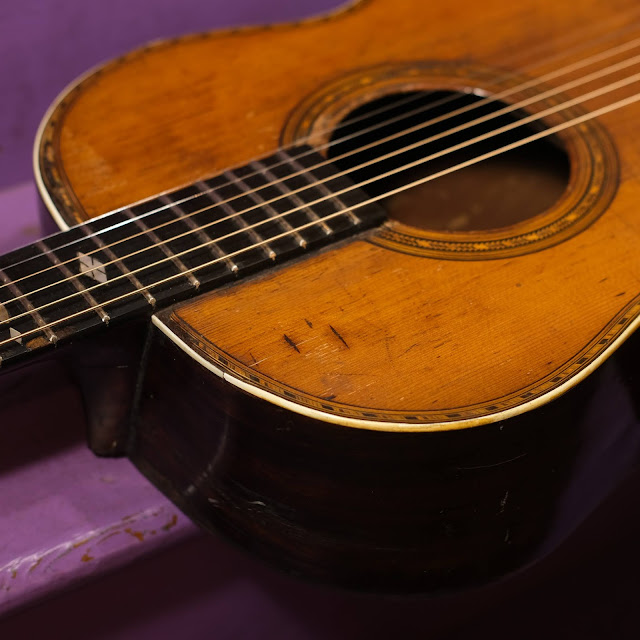1910s Unmarked (Peterson-sold) 000-Size 12-Fret Guitar
So, this guitar -- it's alarmingly-good. It's also completely obscure and bizarre on many levels. It was also one of the worst-wrecked guitars I've seen in a long time -- and I've seen some pretty bad stinkers of late -- remember that '46 LG-2?
The neck joint on this was completely fried. Its block was separated from the top and back, material was missing at the sides and glued-up with all manner of weird backing panels, splits everywhere unglued and splayed-out like fingers, and epoxy had been liberally splashed all over the place. The neck wiggled-around like a joystick.
Suffice to say, after just the right amount of excruciating repair-pain, this box is glorious. It's a 000-size, 12-fret body which means it has a lot of airspace inside. It has a long scale length at 26 1/8" as well, which means you can more-easily get into baritone ranges with slack tunings and still have them sound full. Extremely-light, scalloped bracing suggests it was built for gut (modern: nylon/classical) strings, but post-work it's happy with up to about 100lb of tension. I have it strung with 52w-11 steel strings tuned down to C#-to-C# overall vs E-to-E standard. The bass notes are full and huge-sounding with tons of warmth behind them. It's something marvelous to play.
Under the hood, it has a really interesting bracing pattern...
While this is clearly an alteration of fan bracing, this brace design is what the (inverted) modern Taylor V-bracing is getting at -- stiffness along the twisting part of the top where the bridge is, light "finger braces" to keep the top flat radiating from it, and reinforcement below the soundhole and directly at the bridge itself.
On this guitar in particular the two main fan braces above and below the bridge are extremely lightweight -- thinner and more scalloped than typical '20s/'30s Martin braces. The finger braces and the extra fan-brace running along the center seam on the lower bout are just as light or lighter and thinner. The bridge plate is a body-width-wide piece of spruce soundboard material (like on many ladder-braced guitars) and the ladder brace below the soundhole is thicker and more substantial.
The repro ebony bridge I made for it has a Hawaiian-y-looking "belly" added for extra grip because I wanted to add as much strength as I could in that area. Otherwise, the bridge matches the dimensions of the (deceased, long-gone) original footprint.
As far as the maker goes, I have no idea. It has an "E. Peterson, Brooklyn, NY" label at the neckblock but Peterson (judging by two other period instruments on the web I found that were clearly imports and not made in the US) seems to have been a repairman or retailer or both, but probably not the builder of this instrument.
For what it's worth, the scale length, trim style, and body size seem to suggest it has relations with the "New York Italian Guild" builders -- like the various (click here, here, here, and here) Cerrito-branded instruments I've worked on in the past. Those builders and their relationship with Oscar Schmidt and its long-scale, 000 guitars seem to suggest this to me, anyway.
However, aside from outward similarities and similar specs, this guitar has nothing in common with those build-wise. First, there's the odd bracing. Next, the back is almost definitely original but appears to be hand-formed, 3-layer ply mahogany with an arch pressed into its rear. The neck is mahogany and features a radiused (12") ebony fretboard with a medium-C rear profile that's fast and comfy. The neck joint is dovetailed and the sides are thin Brazilian rosewood.
Truly, it's an odd duck -- but lovely.
Repairs included: wrangling that neck joint into shape and resetting it while doing so. Epoxy in the joint and all under the fretboard extension and bracing below it meant I had to use the "slipped back" method to set the angle and then really fuss to get the rosette and extension aligned and the top in that area stable. It worked. There's a ton of disturbance/fill/patches in the heel area of the sides -- some are mine, some are ancient cruddy repairs. I had to work around the problems in order to not cost the owner lots and lots of cashola.
After that: ...there were brace reglues to deal with and repairs of (already thrice-repaired) side cracks all over the place to do. I then cleated all the top cracks and made a new ebony bridge for it. This got a new bone nut and saddle, a board plane, replacement wonky star inlay for the board (the outline was wonky, so the new star is as well), and refret with jumbo/pyramid frets. The last bit was complicated because I had to set frets 1-3 a little higher than the rest due to backbow in that position.
Setup notes: it plays perfectly with 3/32" EA and 1/16" DGBE action at the 12th fret. The neck is effectively straight and it's strung with 52w-11 "custom light" gauges. Tuning is lowered from E-to-E to C#-to-C# -- the same pitches you hear on many old Leadbelly tunes.
Scale length: 26 1/8"
Nut width: 1 13/16"
String spacing at nut: 1 1/2"
String spacing at bridge: 2 3/16"
Body length: 19 7/8"
Lower bout width: 14 3/4"
Waist width: 9 3/8"
Upper bout width: 11"
Side depth at endpin: 4 1/2"
Side depth at endpin: 4 1/2"
Top wood: solid spruce
Sides wood: brazilian rosewood
Back wood: ply mahogany, arched
Back wood: ply mahogany, arched
Bracing type: fan
Fretboard: ebony
Bridge: ebony, replacement
Neck feel: medium C to soft V shape, 12" board radius
Condition notes: I think I more than covered this enough above... but it's very beat throughout, clearly. Everything is original save the bridge, frets, nut, saddle, pins, one pearl inlay, and a few spots of binding I replaced with old stuff.
I forgot to mention that the headstock is actually grafted. By this time that was a pretty rare practice. It's beautiful, too, with a cool little volute at its rear.
I didn't take the latter-era endpin out because it was glued-in and I thought to myself... something bad will happen if I yank it.





















Comments